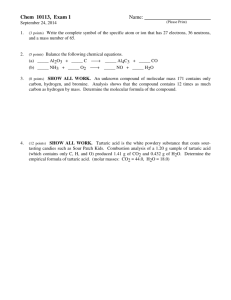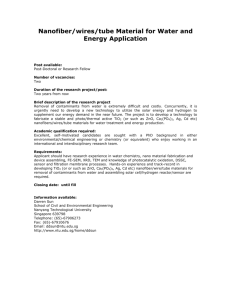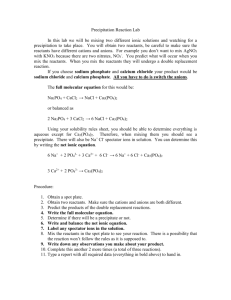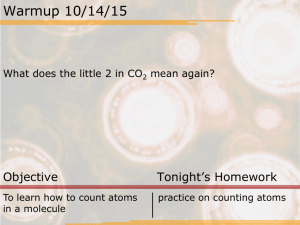A comparison of the Ca (PO ) and CaSiO
advertisement
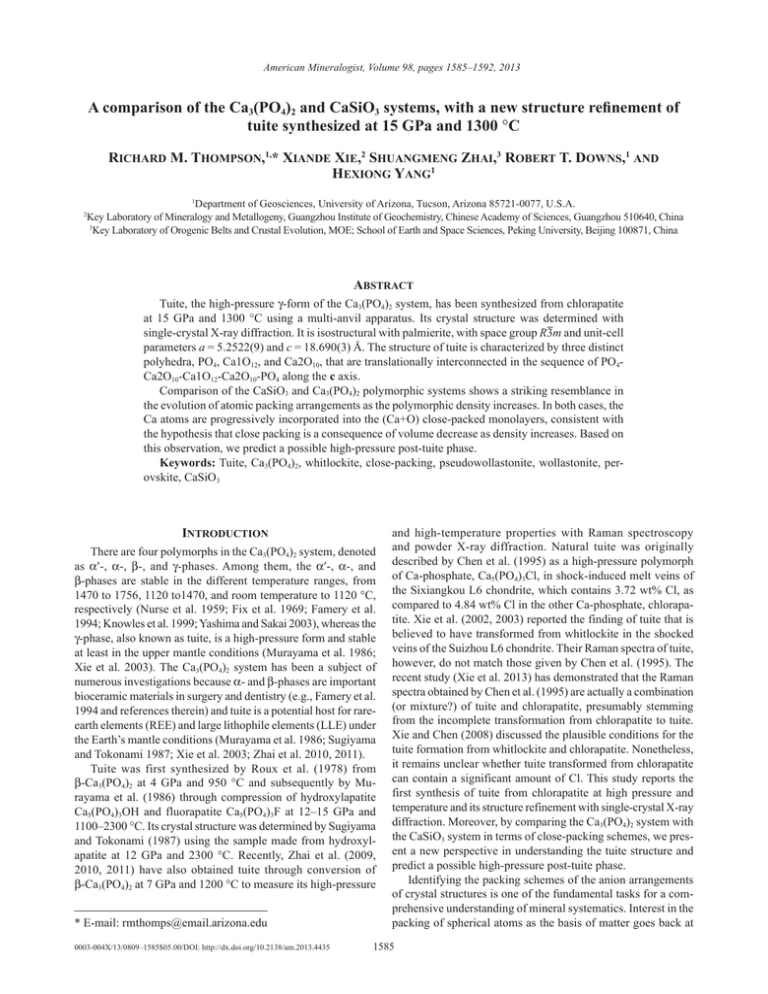
American Mineralogist, Volume 98, pages 1585–1592, 2013 A comparison of the Ca3(PO4)2 and CaSiO3 systems, with a new structure refinement of tuite synthesized at 15 GPa and 1300 °C Richard M. Thompson,1,* Xiande Xie,2 Shuangmeng Zhai,3 Robert T. Downs,1 and Hexiong Yang1 1 Department of Geosciences, University of Arizona, Tucson, Arizona 85721-0077, U.S.A. Key Laboratory of Mineralogy and Metallogeny, Guangzhou Institute of Geochemistry, Chinese Academy of Sciences, Guangzhou 510640, China 3 Key Laboratory of Orogenic Belts and Crustal Evolution, MOE; School of Earth and Space Sciences, Peking University, Beijing 100871, China 2 Abstract Tuite, the high-pressure γ-form of the Ca3(PO4)2 system, has been synthesized from chlorapatite at 15 GPa and 1300 °C using a multi-anvil apparatus. Its crystal structure was determined with single-crystal X‑ray diffraction. It is isostructural with palmierite, with space group R3m and unit-cell parameters a = 5.2522(9) and c = 18.690(3) Å. The structure of tuite is characterized by three distinct polyhedra, PO4, Ca1O12, and Ca2O10, that are translationally interconnected in the sequence of PO4Ca2O10-Ca1O12-Ca2O10-PO4 along the c axis. Comparison of the CaSiO3 and Ca3(PO4)2 polymorphic systems shows a striking resemblance in the evolution of atomic packing arrangements as the polymorphic density increases. In both cases, the Ca atoms are progressively incorporated into the (Ca+O) close-packed monolayers, consistent with the hypothesis that close packing is a consequence of volume decrease as density increases. Based on this observation, we predict a possible high-pressure post-tuite phase. Keywords: Tuite, Ca3(PO4)2, whitlockite, close-packing, pseudowollastonite, wollastonite, perovskite, CaSiO3 Introduction There are four polymorphs in the Ca3(PO4)2 system, denoted as α′-, α-, β-, and γ-phases. Among them, the α′-, α-, and β-phases are stable in the different temperature ranges, from 1470 to 1756, 1120 to1470, and room temperature to 1120 °C, respectively (Nurse et al. 1959; Fix et al. 1969; Famery et al. 1994; Knowles et al. 1999; Yashima and Sakai 2003), whereas the γ-phase, also known as tuite, is a high-pressure form and stable at least in the upper mantle conditions (Murayama et al. 1986; Xie et al. 2003). The Ca3(PO4)2 system has been a subject of numerous investigations because α- and β-phases are important bioceramic materials in surgery and dentistry (e.g., Famery et al. 1994 and references therein) and tuite is a potential host for rareearth elements (REE) and large lithophile elements (LLE) under the Earth’s mantle conditions (Murayama et al. 1986; Sugiyama and Tokonami 1987; Xie et al. 2003; Zhai et al. 2010, 2011). Tuite was first synthesized by Roux et al. (1978) from β-Ca3(PO4)2 at 4 GPa and 950 °C and subsequently by Murayama et al. (1986) through compression of hydroxylapatite Ca5(PO4)3OH and fluorapatite Ca5(PO4)3F at 12–15 GPa and 1100–2300 °C. Its crystal structure was determined by Sugiyama and Tokonami (1987) using the sample made from hydroxylapatite at 12 GPa and 2300 °C. Recently, Zhai et al. (2009, 2010, 2011) have also obtained tuite through conversion of β-Ca3(PO4)2 at 7 GPa and 1200 °C to measure its high-pressure * E-mail: rmthomps@email.arizona.edu 0003-004X/13/0809–1585$05.00/DOI: http://dx.doi.org/10.2138/am.2013.4435 and high-temperature properties with Raman spectroscopy and powder X‑ray diffraction. Natural tuite was originally described by Chen et al. (1995) as a high-pressure polymorph of Ca-phosphate, Ca5(PO4)3Cl, in shock-induced melt veins of the Sixiangkou L6 chondrite, which contains 3.72 wt% Cl, as compared to 4.84 wt% Cl in the other Ca-phosphate, chlorapatite. Xie et al. (2002, 2003) reported the finding of tuite that is believed to have transformed from whitlockite in the shocked veins of the Suizhou L6 chondrite. Their Raman spectra of tuite, however, do not match those given by Chen et al. (1995). The recent study (Xie et al. 2013) has demonstrated that the Raman spectra obtained by Chen et al. (1995) are actually a combination (or mixture?) of tuite and chlorapatite, presumably stemming from the incomplete transformation from chlorapatite to tuite. Xie and Chen (2008) discussed the plausible conditions for the tuite formation from whitlockite and chlorapatite. Nonetheless, it remains unclear whether tuite transformed from chlorapatite can contain a significant amount of Cl. This study reports the first synthesis of tuite from chlorapatite at high pressure and temperature and its structure refinement with single-crystal X‑ray diffraction. Moreover, by comparing the Ca3(PO4)2 system with the CaSiO3 system in terms of close-packing schemes, we present a new perspective in understanding the tuite structure and predict a possible high-pressure post-tuite phase. Identifying the packing schemes of the anion arrangements of crystal structures is one of the fundamental tasks for a comprehensive understanding of mineral systematics. Interest in the packing of spherical atoms as the basis of matter goes back at 1585 1586 THOMPSON ET AL.: THE Ca3(PO4)2 AND CaSiO3 SYSTEMS least to the late 16th century (Hales 2000). Many ionic crystal structures have been successfully rationalized as composed of close-packed (CP) arrangements of large anions with small cations filling the interstitial voids in the anion scaffold. An example of a useful application of this concept is Pauling’s (1929) radius-ratio rule for predicting cation coordination numbers from cation:anion radius ratios. Underlying the concept of large anions/small cations is the assumption that oxygen anions form CP arrangements to minimize structural volume. From this perspective, there is nothing to bar cations from inclusion with O atoms in CP arrangements should size considerations allow. This is in fact seen in the perovskite structure (cf. Klein and Dutrow 2008). The fundamental building blocks of three-dimensional closest-packed arrangements are two-dimensional CP monolayers, in which each sphere is in contact with six nearest neighbors. The CP stacking of monolayers give rise to interstitial (cation) sites that are trigonal planar, tetrahedral, or octahedral. All tetrahedral sites in any CP arrangement have bases perpendicular to a stacking direction with apices pointing parallel to the stacking vectors, and therefore have at least one face parallel to at least one face in all other tetrahedra. Any two tetrahedra sharing corners have either coplanar bases containing the shared sphere or parallel bases with a shared apical sphere, forming a unit resembling an hourglass. Crystal structures that violate these conditions are either very distorted or not based on the closepacking arrangement. Nevertheless, small systematic alterations to CP monolayers can create layers that can be stacked forming tetrahedral and high coordination number sites that violate these rules (Thompson et al. 2012). CP monolayers are typically distinctive but may be difficult to recognize in minerals that are quite distorted from closest-packed. Thompson and Downs (2001) introduced a parameter, Ucp, to quantify the degree of distortion of the oxygen anion skeletons of minerals from the perfectly closest-packed arrangement. In the cubic closest-packing or CCP (hexagonal closest-packing or HCP) case, Ucp is the minimum mean square displacement of 675 (677) corresponding anions contained in a spherical volume of space in the ideal structure. This parameter is calculated by allowing the ideal structure to translate, rotate, and isotropically expand or compress relative to the observed structure until the minimum value (Ucp) is found. A value of zero for Ucp indicates an anion skeleton that is perfectly closest-packed, with distortion increasing as Ucp gets larger. A value of one indicates an oxygen arrangement that is extremely distorted. We will use Ucp in this paper to examine the distortion from perfect closest-packing of minerals of interest. In addition, we will adopt the terms eutaxy and eutactic arrangement to describe an arrangement with the same spatial relationships as close-packing, but where the packed units are not necessarily believed to be in contact (after O’Keeffe and Hyde 1996), i.e., as a more general term that can be used synonymously. Experimental methods The tuite sample used in this study was synthesized using synthetic chlorapatite as starting material at high pressure and high temperature. First, reagent-grade CaCO3, NH4Cl, and NH4H2PO4 powders were mixed in a proportion corresponding to the Ca5(PO4)3Cl stoichiometry. The mixture was ground for 2 h in an agate mortar and pressed into pellets with a diameter of 5 mm under uniaxial pressure of 30 MPa. The pellets were then sintered in a conventional muffle furnace at 1000 °C for 36 h to form a single phase of Ca5(PO4)3Cl, which was confirmed by powder X‑ray diffraction. The Ca5(PO4)3Cl powder was then put into a Pt capsule to synthesize tuite at 15 GPa and 1300 °C for 24 h using a multi-anvil apparatus. The high-pressure and high-temperature experimental details were described by Xue et al. (2009). The final product was characterized by microfocused X‑ray diffraction and Raman spectroscopy. Chemical compositions of the synthesized sample were determined by an electron probe microanalyzer (JXA-8800) operated at 15 kV and 12 nA. The average composition (10 analysis points) is (wt%) CaO 54.2(3), P2O5 46.2(7), and total = 100.4(9), yielding an empirical formula (based on 8 O apfu) Ca2.98(P1.01O4)2. Single-crystal X‑ray diffraction data of tuite were collected from a nearly equi-dimensional crystal (0.04 × 0.05 × 0.05 mm) with frame widths of 0.5° in ω and 30 s counting time per frame. All reflections were indexed on the basis of a trigonal unit-cell (Table 1). The intensity data were corrected for X‑ray absorption using the Bruker program SADABS. The systematic absences of reflections suggest possible space groups R32, R3m, or R3m. The crystal structure was solved and refined using SHELX97 (Sheldrick 2008) based on the space group R3m, because it yielded the best refinement statistics in terms of bond lengths and angles, atomic displacement parameters, and R factors. The positions of all atoms were refined with anisotropic displacement parameters. During the structure refinements, the ideal chemistry was assumed. Final coordinates and displacement parameters of atoms in tuite are listed in Table 2, and selected bond distances in Table 3. (CIF1 available on deposit.) Discussion The structure of tuite Tuite belongs to a vast group of compounds with the palmierite-type structure and the general chemical formula M3(XO4)2, where M = Ba, Sr, Ca, Pb, Rb, K, Na, NH4, Tl, REE, and X = V, Cr, P, S, As. Depending on the chemistry, the palmierite-type materials can exhibit various interesting optical, transport, catalytic, dielectric, and ferroelectric properties (e.g., Leonidova and Leonidova 2008; Sahoo et al. 2010 and references therein). The X cation in the palmierite-type structure is tetrahedrally coordinated, whereas the M cations occupy two symmetrically nonequivalent sites, M1 and M2. The M1 site displays a (6+6) Deposit item AM-13-805, CIF. Deposit items are available two ways: For a paper copy contact the Business Office of the Mineralogical Society of America (see inside front cover of recent issue) for price information. For an electronic copy visit the MSA web site at http://www.minsocam.org, go to the American Mineralogist Contents, find the table of contents for the specific volume/issue wanted, and then click on the deposit link there. 1 Table 1. Summary of crystal data and refinement results for synthetic tuite Ideal chemical formula Ca3(PO4)2Ca3(PO4)2 Synthesis conditions 15 GPa, 1300 °C 12 GPa, 2300 °C Starting material Ca5(PO4)3ClCa5(PO4)3OH Crystal size (mm) 0.05 × 0.05 × 0.04 0.09 × 0.09 × 0.07 Space group R3mR3m a (Å) 5.2522(9)5.2487(6) c (Å) 18.690(3)18.674(3) V (Å3) 446.5(2)445.5(1) Z 3 3 ρcal (g/cm3) 3.4613.469 λ (Å, MoKα) 0.710730.71069 µ (mm–1) 3.333.20 2θ range for data collection ≤66.0860.0 No. of reflections collected 1495 753 No. of independent reflections 243 No. of reflections with I > 2σ(I) 216 201 [I > 3σ(I)] No. of parameters refined 19 Rint0.016 Final R1, wR2 factors [I > 2σ(I)] 0.018, 0.051 0.048, 0.053 Final R1, wR2 factors (all data) 0.021, 0.053 Goodness-of-fit1.080 Reference (1)(2) Note: References: (1) This study; (2) Sugiyama and Tokonami (1987). THOMPSON ET AL.: THE Ca3(PO4)2 AND CaSiO3 SYSTEMS 1587 Table 2. Coordinates and displacement parameters of atoms in synthetic tuite Atom x y zUeq U11 U22 U33 U23 U13 U12 Ca1 0 0 0 0.0128(2)0.0163(3)0.0163(3)0.0058(3) 0 0 0.0082(1) Ca2 0 0 0.20359(2)0.0100(2)0.0116(2)0.0116(2)0.0069(2) 0 0 0.0058(1) P 0 0 0.40508(3)0.0060(2)0.0064(2)0.0064(2)0.0052(3) 0 0 0.0032(1) O1 0 0 0.32372(8)0.0151(4)0.0193(6)0.0193(6)0.0066(7) 0 0 0.0097(3) O2 0.1737(1)0.3474(2)0.09950(4)0.0114(2)0.0139(4)0.0073(4)0.0106(4)0.0005(3)0.0002(1)0.0036(2) Table 3. Selected bond distances (Å) in synthetic tuite Ca1-O1x6 Ca1-O2x6 Avg. Ca2-O1 Ca2-O2x3 Ca2-O2x6 Avg. P-O1 P-O2x3 Avg. This study Sugiyama and Tokonami (1987) 3.0377(5) 3.0359(4) 2.4404(9) 2.440(3) 2.739 2.739 2.245(2) 2.239(5) 2.507(1) 2.509(4) 2.6870(5) 2.686(2) 2.589 2.588 1.521(2) 1.526(6) 1.542(1) 1.535(2) 1.537 1.533 coordination, with six M1-O bond lengths markedly shorter than the other six M1-O bonds. In contrast, the M2 site is 10-coordinated. Specifically for tuite, our structure data are very comparable with those determined by Sugiyama and Tokonami (1987) (Tables 1 and 3). The PO4 tetrahedron is slightly distorted, with three P-O2 bond distances (1.542 Å) longer than the one P-O1 bond distance (1.521 Å). The average M1-O and M2-O bond distances are 3.0377 and 2.4404 Å, respectively. The detailed linkage among the PO4, M1O12, and M2O10 polyhedra has been elucidated by Sugiyama and Tokonami (1987). In the following, we will offer a different view of the tuite structure by placing it into the context of the Ca3(PO4)2 and CaSiO3 polymorphic systems. Both systems contain at least four phases, in each case with Ca as the only non-tetrahedral cation; both contain phases [β-Ca3(PO4)2 and pseudowollastonite] that exhibit large, multipolyhedral structural subunits functioning as ligands, and both contain structures that incorporate Ca cations and O anions into a single packing arrangement. To better understand the Ca3(PO4)2 system, we will first review the CaSiO3 system and use the principles that apparently govern both of them to make a prediction. be thought of as functioning as close-packed monolayers of [Si3O9]6– ligands. These ligands are not in three-dimensional eutaxy, and there are four different monolayer positions (ABCD) instead of the three (ABC) of close-packed arrangements (Fig. 1b). However, the entire structure of pseudowollastonite can also be regarded as based on close-packing of O and Ca atoms, with each organized into well-defined layers stacked along c* in the a b Review of the CaSiO3 system There are four polymorphs in the CaSiO3 system: pseudowollastonite (Yang and Prewitt 1999), wollastonite (Ohashi and Finger 1978), a high-pressure phase (Trojer 1969), and Caperovskite (Caracas and Wentzcovitch 2006), with densities of 2.90, 2.95, 3.05, and 4.33 g/cm3, respectively (Table 4). Pseudowollastonite is composed of layers of ternary Si3O9 rings (Fig. 1a) alternating with layers of 8-coordinated Capolyhedra stacked along c*. The ternary rings themselves are in two-dimensional eutactic arrangement, and the layers of rings can Figure 1. (a) A layer of [Si3O9]6– ligands in the psuedowollastonite structure. (b) The geometric relationship among layers of [Si3O9]6– ligands looking down c*. Table 4. Crystallographic parameters for CaSiO3 and Ca3(PO4)2 system minerals Name Chemistry pseudowollastoniteCaSiO3 wollastoniteCaSiO3 high-pressure phase Ca0.96Fe0.04SiO3 Ca-perovskiteCaSiO3 α-Ca3(PO4)2 Ca3(PO4)2 β-Ca3(PO4)2 Ca3(PO4)2 γ-Ca3(PO4)2 tuite Ca3(PO4)2 Stacking Ca packing? ρ (gm/cm3) Ucp (Å2)Reference ABABACAC Y 2.90 – Yang and Prewitt 1999 – – 2.95 – Ohashi and Finger 1978 CCP (ABC) N 3.05 2.6 Trojer 1969 CCP (ABC) Y 4.33 0 Caracas and Wentzcovitch 2006 – – 2.81 – Mathew et al. 1977 CCP (ABC) N 3.07 24.7 Dickens et al. 1974 – –3.46– this work Notes: Ucp is a measure of the distortion of the packing arrangement from perfect closest-packing (Thompson and Downs 2001). A value of zero is perfectly closest-packed, and distortion increases as values of Ucp get larger. 1588 THOMPSON ET AL.: THE Ca3(PO4)2 AND CaSiO3 SYSTEMS sequence ABABACACABABACAC (Fig. 2). Three quarters of these layers, including the Ca layers, are easily recognizable as close-packed monolayers. As an example, Figure 3 illustrates in isolation the four Ca monolayers labeled A in Figure 2, viewed down the stacking direction, c*, with all other atoms removed. Clearly, the atoms in these four layers align and are equivalent in terms of their function in the stacking sequence. The remaining layers labeled A contain O atoms coplanar with Si atoms in six-membered atomic rings (Fig. 4a, again viewed down the stacking vector). These layers may at first appear to be non-CP, but Figure 4b shows the correspondence between the O atoms in these layers and the Ca atoms in the nearest Ca-monolayer (labeled A). Thus, these O-layers are actually equivalent to A layers, but distorted by the presence of the coplanar Si atoms. This distortion allows for the formation of tetrahedral sites with geometrical relationships that would not be possible in the perfectly closest-packed arrangement of spheres with stacking sequence ABABACAC. Consideration of just the O atoms in pseudowollastonite also yields a CP arrangement with stacking sequence BABCAC, or, equivalently, ABACBC. When every octahedral site formed by two O-monolayers is occupied (brucite-type layer), the cations form a eutactic monolayer of their own. This begs the question: should the Ca-monolayers be considered part of the packing, or just cations in the interstitial sites of a CP oxygen skeleton? In any ideal CP arrangement, the distance between monolayers is twice the distance between the cation layer and the nearest monolayer. In pseudowollastonite, the average distance between O-monolayers is only 38% longer than the average distance between Ca- and O-monolayers. This is consistent with the Ca atoms functioning as part of the packing arrangement, albeit with an effective radius approximately 70% of that of the O atoms. Electron density analysis of pseudowollastonite could provide sizes for its ionic radii. Wollastonite is a member of the pyroxenoid group of minerals, often described as similar to the pyroxene group because both groups contain single tetrahedral silicate chains connecting layers of chains of octahedrally coordinated cations (cf. Klein and Dutrow 2008). Figure 5a shows the wollastonite tetrahedral chain and its relationship to the octahedral chain with which it shares its apical O atoms. Figure 5b illustrates the analogous structural subunits in hypothetical ideal CCP and HCP wollastonite chains, formed from the two possible CP arrangements of three CP monolayers, demonstrating that the wollastonite tetrahedral chain a Figure 2. The atomic packing arrangement of pseudowollastonite, illustrating the incorporation of Ca atoms into the arrangement. b Figure 3. The eutactic Ca monolayers that intersect the unit cell in psuedowollastonite viewed in isolation down the stacking direction, c*, with all other atoms removed. This cartoon shows that these layers all align and are all A layers. Figure 4. (a) (O+Si) layers viewed down c* in psuedowollastonite. (b) The relationship between the oxygen atoms in the (O+Si) layers in psuedowollastonite and the nearest Ca layer along c*, illustrating that the O layers are distorted A layers in the stacking sequence. THOMPSON ET AL.: THE Ca3(PO4)2 AND CaSiO3 SYSTEMS does not directly correspond to a CP arrangement. In fact, it can best be described as a hybrid between the possible CCP and HCP configurations. Therefore, wollastonite is very distorted from either CCP or HCP, and our software failed to calculate a Ucp value for it, with or without including Ca in the packing scheme. Trojer (1969) presented a refinement of a CaSiO3 phase synthesized at 6.5 GPa and 1300 °C. Our program calculated a Ucp value of 2.6 Å2 from ideal CCP for the oxygen anion arrangement, but failed when any Ca was included in the packing arrangement. This value indicates an extremely distorted structure, and it is difficult to recognize distinct CP layers in the structure. Figure 6a illustrates the crystal structure viewed down zone [21 1], not identified as a CP stacking direction by our software. It is composed of non-eutactic Ca layers alternating with layers containing both O and Ca, one Ca layer for every two (O+Ca) layers. Figure 6b displays an (O+Ca) layer viewed down zone [425] [face pole (111)], showing Ca incorporated into the O layers, in which each Ca atom is surrounded by five nearest O atoms. The Ca:O ratio in each (Ca+O) layer, nevertheless, is 1: 9. Applying a two-dimensional radius ratio analysis to this configuration yields a Ca radius 70% that of oxygen, the same value derived through analysis of the stacking sequence of pseudowollastonite. CaSiO3 assumes the perovskite structure at extremely high pressure (hereafter referred to as Ca-pv). Using density functional theory, Caracas and Wentzcovitch (2006) calculated hypothetical 1589 room-condition cell parameters for ideal cubic Ca-pv (positional parameters are fixed). This structure has a Ucp value of 0, meaning that it is perfectly closest-packed, with all Ca atoms incorporated into the CP monolayers in a Ca:O ratio of 1:3 (Fig. 7). In short, as the CaSiO3 polymorphs increase in density, Ca is progressively incorporated into the layers of O atoms. In pseudowollastonite, the lowest density polymorph examined here, Ca is excluded from the O monolayers, forming monolayers of its own. In wollastonite, the Ca atoms occupy classic interstitial octahedral sites. In the higher density synthetic phase of Trojer (1969), one-third of the Ca atoms are incorporated into layers with O atoms. Finally, in the perovskite structure, all Ca atoms combine with O atoms to form (Ca+O) CP monolayers. The Ca3(PO4)2 system This set of polymorphs includes α-Ca3(PO4)2 (Mathew et al. 1977), β-Ca3(PO4)2 (Dickens et al. 1974), and tuite or γ-Ca3(PO4)2 (this work), with densities 2.81, 3.07, and 3.46 g/cm3, respectively (Table 4). Note that the α′-phase is excluded from the a a b b Figure 6. (a) Layering in the high-pressure synthetic CaSiO3 phase of Trojer (1969) looking down zone [21 1]. (b) The (O+Ca) layer viewed down zone [425] showing the incorporation of Ca into O layers in the high-pressure CaSiO3 phase of Trojer (1969). Figure 5. (a) The tetrahedral and octahedral chains in wollastonite (Ohashi and Finger 1978). (b) Hypothetical ideal CP wollastonite analogs. Figure 7. The perfectly closest-packed monolayer of O anions and Ca cations, viewed along [111], in a hypothetical room condition perovskite (Caracas and Wentzcovitch 2006). 1590 THOMPSON ET AL.: THE Ca3(PO4)2 AND CaSiO3 SYSTEMS discussion here, because it is an unquenchable high-temperature form and its structure symmetry is still a matter of disputation. For example, by means of high-temperature neutron powder diffraction, Knowles et al. (1999) and Yashima and Sakai (2003) obtained space group P63/mmc (at 1525 °C) and P3m (at 1508 °C), respectively. The structure of α-Ca3(PO4)2 consists of 12 nonequivalent isolated PO4 tetrahedra sharing corners and edges with 18 nonequivalent Ca-polyhedra of various coordination numbers and geometries. We were unable to calculate a Ucp value for this structure, nor identify any distinct atomic layers. β-Ca3(PO4)2 possesses the whitlockite-type structure. Like pseudowollastonite, it is also based on an eutactic arrangement of large ligands, but, unlike pseudowollastonite, we uncovered no packing arrangement involving individual atoms. Some indistinct atomic layering is evident when viewing the structure perpendicular to c, including non-CP layers that are distorted in three dimensions but incorporate Ca in a Ca:O ratio of 5:6. The β-phase appears to be intermediate between α-Ca3(PO4)2, with its complete absence of layering, and tuite, which has a very distinct layered structure (as described below). The large β-phase ligands are in three-dimensional distorted eutaxy and have a formula [Ca(PO4)6]16– (Fig. 8a). They consist of central Ca octahedra sharing corners with six PO4 tetrahedra, thus forming flattened disks (or “pinwheels,” see Moore 1973) that stack in a distorted CCP arrangement. The ligands’ central Ca atoms have ideal CCP positional parameters, but their flattened geometry creates a very distorted cell, leading to an enormous Ucp value of 24.7 Å2. As in pseudowollastonite, the ligands cannot be considered to be in contact, as they are separated by Ca2+ cations. For an in-depth discussion of the whitlockite-type structure, see Tait et al. (2011). Tuite bears a superficial visual resemblance to β-Ca3(PO4)2 because one can visualize “pinwheels” (Moore 1973) in both structures (Fig. 8b). However, the pinwheels in tuite are combined into corner-sharing polymerized polyhedral layers, not containing distinct pinwheel ligands. As discussed below, Ca in tuite is part of the packing arrangement, and the Ca2-O2 bonds bind the polyhedral layers together to form a three-dimensional structure. The Ca participation in the packing scheme increases density relative to the β-phase and allows a much more distinct layering of individual atoms. We analyze tuite from this perspective. All Ca atoms in tuite are incorporated with oxygen into eutactic monolayers of individual atoms (as opposed to layers of polyhedra) and stacked in a non-CP sequence along c that can be described as A′ABA′CAA′BC (Fig. 9). Figures 10a and 10b illustrate tuite’s two types of (Ca+O) layers—A′ and A (B and C are equivalent to A, and are stacked in eutactic relationship with A, but not A′, along c), respectively. Layers A, B, and C are perovskite-type layers (Fig. 7), and form a distorted CCP arrangement of O and Ca atoms. Layer A′ is also eutactic, but contains only three unit-cell atoms for every four in layer A (a Ca:O ratio of 1:2 instead of 1:3 in the pv-type monolayers). This allows for an unusual geometric relationship with the A (and B and C) layers in which two-thirds of the A′ atoms (all of the Ca and one-half of the O) are in eutactic relationship with A, but one-half of the O atoms are on vectors parallel to c that also pass through Ca atoms in layer A (these vectors are not illustrated in a b Figure 8. (a) A layer of “pinwheels” viewed down c in β-Ca3(PO4)2. Isolated spheres are Ca atoms, interstitial in the eutactic monolayer of [Ca(PO4)6]16– ligands. Eutaxy is defined as having the same geometric relationships as close-packing, without the requirement of being in contact (O’Keeffe and Hyde 1996). (b) A polyhedral layer in tuite viewed down c, which could reasonably be considered a polymerized sheet of pinwheels. Figure 9. The packing arrangement of tuite. Fig. 9, lines shown are the unit cell). For example, in Figures 10a and 10b, there are atoms in both layers at [2⁄3, 1⁄3, z]. The non-eutactic packing arrangement of tuite increases its bulk Ca:O ratio from 3:9 in Ca-pv to 3:8. Given the similarities between the Ca3(PO4)2 and the CaSiO3 polymorphic systems, it is THOMPSON ET AL.: THE Ca3(PO4)2 AND CaSiO3 SYSTEMS a 1591 al. 2001; Mikouchi et al. 2001; Gnos et al. 2002), one may also propose, by the same token, the possible F-bearing analog of tuite through the coupled substitution Na++F– → Ca2++O2–, leading to the chemical formula CaNa2(PO3F)2. Apparently, further hightemperature and high-pressure experiments with appropriate chemical compositions could shed light on the above proposals. Acknowledgments We gratefully acknowledge the funding support from the National Natural Science Foundation of China (Grant No. 41172046 to X.X. and Grant No. 40973045 to S.Z.), and the Science Foundation Arizona. We are also indebted to Fabrizio Nestola and an anonymous reviewer for their valuable suggestions, which have improved the quality of our manuscript. References cited b Figure 10. (a) The A′ layer in tuite. (b) The A layer in tuite. a reasonable prediction that tuite will transform under pressure to a structure that has a eutactic packing arrangement incorporating both the oxygen and calcium atoms. However, such a structure would be constrained to have the same number of atoms per unit cell in each monolayer, unlike tuite. While Ca:O ratios in different monolayers could vary, the bulk Ca:O ratio would still have to be 3:8. We have not discovered an arrangement that would meet these constraints and distribute Ca as “evenly” in the monolayers as it is in the A′ monolayers and in the pv-type layers (i.e., every nearest neighbor Ca-Ca distance is the same in both layer types). Possible OH- or F-bearing analog of tuite Several palmierite-type compounds are capable of incorporating H atoms into their structures as an essential component, such as previously observed for Cs3H(SeO4)2 (Merinov et al. 1990; Sonntag et al. 1998), Rb3H(SeO4)2 (Baranov et al. 1987; Magome et al. 2009), Tl3H(SO4)2 (Matsuo et al. 2002), and K3H(SO4)2 (Makarova et al. 2010). This, thus, calls it into question whether tuite can accommodate any H atoms during its formation from hydroxylapatite and whitlockite, ideally Ca9Mg(PO4)6(PO3OH), at high temperatures and pressures. A possible mechanism for introducing H to the tuite structure might be through the substitution (Na++H+ → Ca2+), giving rise to a chemical formula Ca2NaH(PO4)2 or CaNa2(PO3OH)2. Interestingly, tuite from the Suizhou L6 chondrite is found to contain a significant amount of Na, (Ca2.51Mg0.29)2.80Na0.28(P1.01O4)2 (Xie et al. 2003). Moreover, since tuite can also be obtained from fluorapatite at high temperatures and pressures, and the whitlockite-bobdownsite (the F-analog of whitlockite) solid solution has been found in various meteorites (e.g., Treiman et al. 1994; Gleason et al. 1997; Lodders 1998; Zipfel et al. 2000; Folco et al. 2000; Wadhwa et Baranov, A.I., Makarova, I.P., Muradyan, L.A., Tregubchenko, A.V., Shuvalov, L.A., and Simonov, V.I. (1987) Phase transition and proton conductivity in Rb3H(SeO4)2 crystals. Kristallografiya, 32, 400–407. Caracas, R. and Wentzcovitch, R.M. (2006) Theoretical determination of the structures of the CaSiO3 perovskites. Acta Crystallographica, B62, 1025–1030. Chen, M., Wopenka, B., Xie, X., and El Goresy, A. (1995) A new high-pressure polymorph of chlorapatite in the shocked chondrite Sixiangkou (L6). Lunar Planetary Sciences, XXVI, 237–238. Dickens, B., Schroeder, L.W., and Brown, W.E. (1974) Crystallographic studies of the role of Mg as a stabilizing impurity in β-Ca3(PO4)2 I. The crystal structure of pure β-Ca3(PO4)2. Journal of Solid State Chemistry, 10, 232–248. Famery, R., Richard, N., and Boch, P. (1994) Prepartion of α- and β-tricalcium phosphate ceramics, with and without magnesium additions. Ceramics International, 20, 327–336. Fix, W., Heymann, H., and Heinke, R. (1969) Subsolidus relations in the system 2CaO⋅SiO2-3CaO⋅P2O5. Journal of American Ceramic Society, 52, 346–347. Folco, L., Franchi, I.A., D’Orazio, M., Rocchi, S., and Schultz, L. (2000) A new Martian meteorite from the Sahara: the shergottite Dar al Gani 489. Meteoritics and Planetary Sciences, 35, 827–839. Gleason, J.D., Kring, D.A., Hill, D.H., and Boynton, W.V. (1997) Petrography and bulk chemistry of Martian lherzolite LEW 88516. Geochimica et Cosmochimica Acta, 61, 4007–4014. Gnos, E., Hofmann, B., Franchi, I.A., Al-Kathiri, A., Hauser, M., and Moser, L. (2002) Sayh al Uhaymir 094: a new Martian meteorite from the Oman desert. Meteoritics and Planetary Sciences, 37, 835–854. Hales, T.C. (2000) Cannonballs and honeycombs. Notices of the American Mathematical Society, 47, 440–449. Klein, C. and Dutrow, B. (2008) The Manual of Mineral Science. Wiley, Hoboken, New Jersey. Knowles, J.C., Gibson, I.R., and Abrahams, I. (1999) High temperature phase transitions in Ca3(PO4)2 measured by neutron diffraction. Bioceramics, 12, 341–344. Leonidova, O.N. and Leonidova, E.I. (2008) Synthesis and electrophysical properties of cation conductors Sr3–3xLa2x(V1–yPyO4)2 with palmierite structure. Solid State Ionics, 179, 188–191. Lodders, K. (1998) A survey of shergottite, nakhlite and chassigny meteorites whole-rock compositions. Meteoritics and Planetary Sciences, 33 (Suppl.), A183–A190. Magome, E., Sawada, K., and Komukae, M. (2009) X‑ray structure analysis of Rb3H(SeO4)2 in the high-temperature phase. Ferroelectrics, 378, 157–162. Makarova, I.P., Chernaya, T.S., Filaretov, A.A., Vasil’ev, A.L., Verin, I.A., Grebenev, V.V., and Dolbinina, V.V. (2010) Investigation of the structural conditionality for changes in physical properties of K3H(SO4)2 crystals. Kristallografiya, 55, 429–439. Mathew, M., Schroeder, L.W., Dickens, B., and Brown, W.E. (1977) The crystal structure of α-Ca3(PO4)2. Acta Crystallographica, B33, 1325–1333. Matsuo, Y., Kawachi, S., Shimizu, Y., and Ikehata, S. (2002) Trithallium hydrogen bis(sulfate), Tl3H(SO4)2, in the super-ionic phase by X‑ray powder diffraction, Acta Crystallographica, C58, i92–i94. Merinov, B.V., Baranov, A.I., and Shuvalov, L.A. (1990) Crystal structure and mechanism of protonic conductivity of a superionic phase of Cs3H(SeO4)2. Kristallografiya, 35, 355–360. Mikouchi, T., Miyamoto, M., and McKay, G.A. (2001) Mineralogy and petrology of the Dar al Gani 476 Martian meteorite: implications for its cooling history and relationship to other shergottites. Meteoritics and Planetary Sciences, 36, 531–548. Moore, P.B. (1973) Bracelets and pinwheels: A topological-geometrical approach to the calcium orthosilicate and alkali sulfate structures. American Mineralogist, 58, 32–42. Murayama, J.K., Nakai, S., Kato, M., and Kumazawa, M. (1986) A dense polymorph of Ca3(PO4)2: A high pressure phase of apatite decomposition and its 1592 THOMPSON ET AL.: THE Ca3(PO4)2 AND CaSiO3 SYSTEMS geochemical significance. The Physics of the Earth and Planetary Interiors, 44, 293–303. Nurse, R.W., Welch, J.H., and Gutt, W. (1959) High-temperature phase equilibria in the system dicalcium silicate-tricalcium phosphate. Journal of Chemical Society, 1959, 1077–1083. Ohashi, Y. and Finger, L.W. (1978) The role of octahedral cations in pyroxenoid crystal chemistry. I. Bustamite, wollastonite, and the pectolite-schizoliteserandite series. American Mineralogist, 63, 274–288. O’Keeffe, M. and Hyde, B.G. (1996) Crystal Structures. Monograph, Mineralogical Society of America, Chantilly, Virginia. Pauling, L. (1929) The principles determining the structure of complex ionic crystals. Journal of the American Chemical Society, 51, 1010–1026. Roux, P., Louër, D., and Bonel, G. (1978) Sur une novelle forme cristallite du phosphate tricalcique. Comptes Rendus Hebdomadaires Des Seances De L Academie Des Sciences Serie C, 286, 549–551. Sahoo, P.P., Gaudin, E., Darriet, J., and Guru Row, T.N. (2010) Synthesis, characterization, and crystallographic study of the PbO-Bi2O3-V2O5 system: Pb3–x Bi2x/3V2O8 (0.20 < x 0.50). Inorganic Chemistry, 49, 5603–5610. Sheldrick, G.M. (2008) A short history of SHELX. Acta Crystallographica, A64, 112–122. Sonntag, R., Melzer, R., Knight, K.S., and Radaelli, P.G. (1998) Structural study of the proton conductor Cs3H(SeO4)2 by high resolution neutron powder diffraction. Materials Science Forum, 278, 726–731. Sugiyama, S. and Tokonami, M. (1987) Structure and crystal chemistry of a dense polymorph of tricalcium phosphate Ca3(PO4)2: A host to accommodate large lithophile elements in the Earth’s mantle. Physics and Chemistry of Minerals, 15, 125–130. Tait, K.T., Barkley, M.C., Thompson, R.M., Origlieri, M., Evans, S.H., Prewitt, C.T., and Yang, H. (2011) Bobdownsite, a new member of the whitlockitegroup from Big Fish River, Yukon, Canada. The Canadian Mineralogist, 49, 1065–1078. Thompson, R.M. and Downs, R.T. (2001) Quantifying distortion from ideal closest-packing in a crystal structure with analysis and application. Acta Crystallographica, B57, 119–127. Thompson, R.M., Yang, H., and Downs, R.T. (2012) Packing systematics and structural relationships of the new copper molybdate markascherite and related minerals. American Mineralogist, 97, 1977–1986. Treiman, A.H., McKay, G.A., Bogard, D.D., Mittlefehld, D.W., Wang, M-S., Keller, L., Lipschutz, M.E., Lindstrom, M.M., and Garrison, D. (1994) Comparison of the LEW 88516 and ALHA77005 Martian meteorites: similar but distinct. Meteoritics, 29, 581–592. Trojer, F.J. (1969) The crystal structure of a high-pressure polymorph of CaSiO3. Zeitschrift für Kristallographie, 130, 185–206. Wadhwa, M., Lentz, R.C.F., McSween, H.Y. Jr., and Crozaz, G. (2001) A petrologic and trace element study of Dar al Gani 476 and Dar al Gani 489: twin meteorites with affinities to basaltic and lherzolitic shergottites. Meteoritics and Planetary Sciences, 36, 195–208. Xie, X. and Chen, M. (2008) Formation conditions of tuite. Geochimica, 37, 297–303 (in Chinese with English abstract). Xie, X., Minitti, M.E., Chen, M., Mao, H.K., Wang, D., Shu, J., and Fei, Y. (2002) Natural high-pressure polymorph of merrillite in the shock vein of the Suizhou meteorite. Geochimica et Cosmochimica Acta, 66, 2439–2444. Xie, X., Minitti, M.E., Chen, M., Mao, H.K., Wang, D., Shu, J., Fei, Y. (2003) Tuite, γ-Ca3(PO4)2: A new mineral from the Suizhou L6 chondrite. European Journal of Mineralogy, 15, 1001–1005. Xie, X., Zhai, S., Chen, M., and Yang, H. (2013) Tuite, γ-Ca3(PO4)2, formed from chlorapatite decomposition in the shock vein of the Suizhou L6 chondrite. Meteoritics & Planetary Sciences, in press, DOI: 10.1111/maps.12143. Xue, X., Zhai, S., and Kanzaki, M. (2009) Si-Al distribution in high-pressure CaAl4 Si2O11: A 29Si and 27Al NMR study. American Mineralogist, 94, 1739–1742. Yang, H. and Prewitt, C.T. (1999) On the crystal structure of pseudowollastonite (CaSiO3). American Mineralogist, 84, 929–932. Yashima, M. and Sakai, A. (2003) High-temperature neutron powder diffraction study of the structural phase transition between a and a′ phases in tricalcium phosphate Ca3(PO4)2. Chemical Physics Letters, 372, 779–783. Zhai, S., Liu, X., Shieh, S.R., Zhang, L., and Ito, E. (2009) Equation of state of γ-tricalcium phosphate, γ-Ca3(PO4)2, to lower mantle pressures. American Mineralogist, 94, 1388–1391. Zhai, S., Wu, X., and Ito, E. (2010) High-pressure Raman spectra of tuite, γ-Ca3(PO4)2. Journal of Raman Spectroscopy, 41, 1011–1013. Zhai, S., Xue, W., Lin, C., Wu, X., and Ito, E. (2011) Raman spectra and X‑ray diffraction of tuite at various temperatures. Physics and Chemistry of Minerals, 38, 639–646. Zipfel, J., Scherer, P., Spettel, B., Dreibus, G., and Schultz, L. (2000) Petrology and chemistry of the new shergottite Dar al Gani 476. Meteoritics and Planetary Sciences, 35, 95–106. Manuscript received December 9, 2012 Manuscript accepted April 14, 2013 Manuscript handled by Lars Ehm
